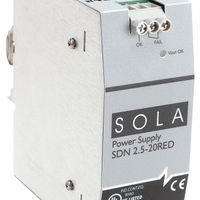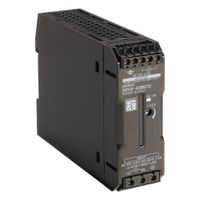Call +(254) 703 030 000 / 751 483 999 / 721 704 777
- Home
- Electrical
- Transformers Ups Power Supplies
- Power Supplies
.....Read More
Frequently Asked Questions
What is the difference between AC and DC power supplies?
AC (Alternating Current) and DC (Direct Current) power supplies differ primarily in the direction and flow of the electric charge.
AC power supplies deliver current that periodically reverses direction. This type of current is typically used in homes and businesses because it is efficient for long-distance transmission. The voltage in AC systems can be easily transformed to higher or lower levels using transformers, making it versatile for various applications. AC power is characterized by its frequency, measured in hertz (Hz), which indicates how many times the current changes direction per second. In most countries, the standard frequency is either 50 Hz or 60 Hz.
DC power supplies, on the other hand, provide current that flows in a single, constant direction. This type of current is commonly used in battery-powered devices, electronics, and applications requiring stable and consistent voltage. DC power is essential for devices like smartphones, laptops, and LED lighting. Unlike AC, DC cannot be easily transformed to different voltage levels without using complex electronic converters.
The choice between AC and DC power supplies depends on the application. AC is preferred for power distribution due to its efficiency in transmission and ease of voltage transformation. DC is favored for electronic devices and applications requiring stable power. Additionally, AC power supplies are generally more complex and can be more expensive to maintain, while DC power supplies are simpler and often more reliable for low-voltage applications.
In summary, the main differences lie in the direction of current flow, ease of voltage transformation, and suitability for different applications, with AC being ideal for power distribution and DC for electronic devices.
How do I choose the right power supply for my device?
1. **Determine Power Requirements**: Check the device's manual or label for voltage (V) and current (A) requirements. Multiply these to find the wattage (W).
2. **Voltage Compatibility**: Ensure the power supply's output voltage matches the device's required voltage. A mismatch can damage the device.
3. **Current Rating**: The power supply's current rating should be equal to or greater than the device's requirement. A higher current rating is safe; the device will only draw what it needs.
4. **Connector Type**: Verify the power supply's connector matches the device's input port. Consider the size, shape, and polarity (positive/negative orientation).
5. **Efficiency and Certification**: Look for power supplies with high efficiency ratings (e.g., 80 Plus certification) to ensure energy savings and reduced heat output.
6. **Regulation and Protection**: Choose a power supply with good voltage regulation and protection features like overcurrent, overvoltage, and short-circuit protection to safeguard your device.
7. **Form Factor and Size**: Ensure the power supply fits the physical space available, especially for internal power supplies in computers or other equipment.
8. **Brand and Quality**: Opt for reputable brands known for reliability and durability. Check reviews and ratings for user experiences.
9. **Environmental Conditions**: Consider the operating environment. If the device will be used in extreme conditions, ensure the power supply is rated for those conditions.
10. **Budget**: Balance cost with quality. While cheaper options may be tempting, investing in a reliable power supply can prevent future issues and expenses.
11. **Future Proofing**: If possible, choose a power supply with slightly higher specifications to accommodate potential future upgrades or additional devices.
What are the common issues with power supplies and how can they be fixed?
Common issues with power supplies include:
1. **Overheating**: Caused by inadequate ventilation or dust accumulation. Fix by ensuring proper airflow, cleaning dust from vents, and using cooling fans.
2. **Voltage Fluctuations**: Can lead to hardware damage. Use a surge protector or an uninterruptible power supply (UPS) to stabilize voltage.
3. **Insufficient Power Output**: Occurs when the power supply cannot meet the system's demands. Upgrade to a higher wattage power supply.
4. **No Power**: Could be due to a faulty power cable or switch. Check and replace cables or test with a different power supply.
5. **Intermittent Power Loss**: Often caused by loose connections. Secure all connections and ensure the power supply is properly seated.
6. **Noise and Buzzing**: Indicates a failing fan or capacitor. Replace the fan or the entire power supply if capacitors are faulty.
7. **Burnt Smell or Smoke**: Sign of a serious fault, possibly a short circuit. Immediately turn off the system and replace the power supply.
8. **Incompatibility**: Ensure the power supply is compatible with the motherboard and other components by checking specifications.
9. **Capacitor Aging**: Over time, capacitors can degrade, leading to power issues. Replace the power supply if capacitors are visibly swollen or leaking.
10. **Fuse Blowing**: Indicates an overload or short circuit. Check for faulty components and replace the fuse with the correct rating.
Regular maintenance, such as cleaning and monitoring power supply health, can prevent many of these issues.
How do I calculate the power requirements for my equipment?
To calculate the power requirements for your equipment, follow these steps:
1. **Identify Equipment Specifications**: Check the nameplate or user manual of each device to find the power rating, usually given in watts (W) or kilowatts (kW). If only voltage (V) and current (A) are provided, calculate power using the formula: Power (W) = Voltage (V) × Current (A).
2. **List All Equipment**: Make a comprehensive list of all equipment you intend to power, noting their individual power ratings.
3. **Calculate Total Power Consumption**: Sum up the power ratings of all devices to get the total power requirement. For example, if you have three devices with power ratings of 100W, 200W, and 300W, the total power requirement is 600W.
4. **Consider Power Factor**: For AC-powered equipment, consider the power factor (PF), which is a measure of how effectively electrical power is converted into useful work output. If the power factor is not 1, adjust the power requirement using: Real Power (W) = Apparent Power (VA) × Power Factor (PF).
5. **Account for Startup Power**: Some equipment, like motors, require more power at startup. Check the startup power requirement and ensure your power source can handle this surge.
6. **Add a Safety Margin**: Add a safety margin (typically 10-20%) to the total power requirement to account for future expansions or unexpected power surges.
7. **Determine Power Source Capacity**: Ensure your power source (e.g., generator, UPS, or electrical circuit) can supply the calculated total power requirement, including the safety margin.
8. **Check Voltage Compatibility**: Ensure that the voltage of your power source matches the voltage requirements of your equipment to avoid damage.
By following these steps, you can accurately determine the power requirements for your equipment and ensure reliable operation.
What are the safety precautions when using power supplies?
1. **Read the Manual**: Always start by reading the manufacturer's manual to understand the specific safety guidelines for your power supply.
2. **Inspect Equipment**: Before use, inspect the power supply and its cables for any signs of damage, such as frayed wires or cracked casings.
3. **Proper Ventilation**: Ensure the power supply is in a well-ventilated area to prevent overheating. Avoid covering vents or placing the unit near heat sources.
4. **Correct Voltage and Current**: Set the power supply to the correct voltage and current for your application to prevent damage to connected devices and the power supply itself.
5. **Use Grounded Outlets**: Connect the power supply to a properly grounded outlet to reduce the risk of electric shock.
6. **Avoid Overloading**: Do not exceed the power supply's maximum output rating. Overloading can cause overheating and potential failure.
7. **Secure Connections**: Ensure all connections are secure and use appropriate connectors to prevent accidental disconnection or short circuits.
8. **Avoid Water and Moisture**: Keep the power supply away from water and moisture to prevent electrical shock and damage.
9. **Use Protective Gear**: Wear appropriate personal protective equipment, such as insulated gloves and safety goggles, when handling power supplies.
10. **Turn Off When Not in Use**: Always turn off and unplug the power supply when not in use or when making adjustments to the connected circuit.
11. **Emergency Procedures**: Be familiar with emergency procedures in case of an electrical accident, such as knowing the location of circuit breakers and first aid kits.
12. **Regular Maintenance**: Perform regular maintenance checks to ensure the power supply is functioning correctly and safely.
13. **Training**: Ensure that anyone using the power supply is properly trained in its operation and safety procedures.
How do I test a power supply to ensure it is working correctly?
1. **Safety First**: Ensure the power supply is unplugged and you are working in a safe environment. Use insulated tools and avoid working on a live circuit.
2. **Visual Inspection**: Check for any physical damage, burnt components, or leaking capacitors. Ensure all connections are secure.
3. **Multimeter Test**:
- Set the multimeter to the correct voltage range.
- Plug in the power supply and turn it on.
- For a computer power supply, use a paperclip to short the green wire (PS_ON) to any black wire (COM) on the 24-pin connector to turn it on.
- Measure the output voltages on the connectors. Common voltages are +3.3V, +5V, and +12V. Compare these with the specifications on the power supply label.
4. **Load Test**:
- Connect the power supply to a load, such as a computer or a power supply tester.
- Ensure the power supply can maintain stable voltages under load. A power supply tester can provide a quick indication of functionality.
5. **Check for Noise and Ripple**:
- Use an oscilloscope to check for excessive noise or ripple in the output voltage, which can indicate a failing power supply.
6. **Temperature and Fan Check**:
- Ensure the power supply fan is operational and the unit does not overheat during operation.
7. **Continuity Test**:
- With the power supply unplugged, use a multimeter to check for continuity in the cables and connectors to ensure there are no breaks.
8. **Final Inspection**:
- After testing, perform a final visual inspection to ensure no components were damaged during testing.
If any test fails, consider replacing the power supply to prevent damage to connected devices.
What are the benefits of using a regulated power supply?
A regulated power supply offers several benefits, ensuring stable and reliable operation of electronic devices and systems:
1. **Voltage Stability**: It maintains a constant output voltage regardless of variations in input voltage or load conditions, protecting sensitive electronic components from damage due to voltage fluctuations.
2. **Improved Performance**: By providing a consistent voltage, it ensures that electronic devices operate at their optimal performance levels, enhancing efficiency and functionality.
3. **Protection Against Overvoltage**: Regulated power supplies often include overvoltage protection, preventing excess voltage from reaching the connected devices, which can prevent potential damage or failure.
4. **Reduced Ripple and Noise**: They minimize electrical noise and voltage ripple, which can interfere with the operation of sensitive electronic circuits, ensuring cleaner power delivery.
5. **Enhanced Device Longevity**: By providing stable power, regulated power supplies help extend the lifespan of electronic components by reducing stress and wear caused by voltage variations.
6. **Safety**: Many regulated power supplies include built-in safety features such as short-circuit protection, thermal shutdown, and current limiting, which protect both the power supply and the connected devices.
7. **Energy Efficiency**: They are designed to be energy-efficient, reducing power consumption and heat generation, which is beneficial for both cost savings and environmental impact.
8. **Versatility**: Regulated power supplies can be used in a wide range of applications, from consumer electronics to industrial equipment, due to their ability to provide precise and reliable power.
9. **Ease of Use**: With features like adjustable output voltage and current, they offer flexibility and ease of use for various applications and testing environments.
10. **Compatibility**: They ensure compatibility with a wide range of electronic devices, making them suitable for diverse applications in different industries.

